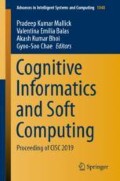Abstract
We propose bilingually compelled recursive auto-encoders (BRAE) to learn semantic expression embedding (smaller vector portrayals for phrases), which can recognize the expressions with various semantic implications. The BRAE is prepared in a way that limits the semantic separation of interpretation counterparts. Also, it augments the semantic separation of non-translation combinations at the same time. The model identifies how to insert each expression semantically in two dialects and also identifies how to change semantic inserting space in one dialect to the other. We assess our proposed strategy on two end-to-end SMT assignments (express table pruning and interpreting with phrasal semantic likenesses) which need to quantify semantic likeness between a source expression and its interpretation. The detailed tests demonstrate that the BRAE is strikingly compelling in these two assignments.
Access this chapter
Tax calculation will be finalised at checkout
Purchases are for personal use only
References
Zhang, J., Liu, S., Li, M., Zhou, M., Zong, C.: Bilingually-constrained Phrase Embeddings for Machine Translation. National Laboratory of Pattern Recognition, CASIA, Beijing, P.R. China
Auli, M., Galley, M., Quirk, C., Zweig, G.: Joint language and translation modeling with recurrent neural networks. In: Proceedings of the 2013 Conference on Empirical Methods in Natural Language Processing, pp. 1044–1054 (2013)
Li, P., Liu, Y., Sun, M.: Recursive autoencoders for ITG-based translation. In: Proceedings of the Conference on Empirical Methods in Natural Language Processing (2013)
Liu, L., Watanabe, T., Sumita, E., Zhao, T.: Additive neural networks for statistical machine translation. In: 51st Annual Meeting of the Association for Computational Linguistics, pp. 791–801 (2013)
Duh, K., Neubig, G., Sudoh, K., Tsukada, H.: Adaptation data selection using neural language models: experiments in machine translation. In: 51st Annual Meeting of the Association for Computational Linguistics, pp. 678–683 (2013)
Gao, J., He, X., Yih, W.-T., Deng, L.: Learning semantic representations for the phrase translation model. arXiv preprint arXiv:1312.0482 (2013)
Vaswani, A., Zhao, Y., Fossum, V., Chiang, D.: Decoding with largescale neural language models improves translation. In: Proceedings of the 2013 Conference on Empirical Methods in Natural Language Processing, pp. 1387–1392 (2013)
Yang, N., Liu, S., Li, M., Zhou, M., Yu, N.: Word alignment modeling with context dependent deep neural network. In: 51st Annual Meeting of the Association for Computational Linguistics (2013)
Zou, W.Y., Socher, R., Cer, D., Manning, C.D.: Bilingual word embeddings for phrase-based machine translation. In: Proceedings of the 2013 Conference on Empirical Methods in Natural Language Processing, pp. 1393–1398 (2013)
Zens, R., Stanton, D., Xu, P.: A systematic comparison of phrase table pruning techniques. In: Proceedings of the 2012 Joint Conference on Empirical Methods in Natural Language Processing and Computational Natural Language Learning, pp. 972–983 (2012)
Author information
Authors and Affiliations
Corresponding author
Editor information
Editors and Affiliations
Rights and permissions
Copyright information
© 2020 Springer Nature Singapore Pte Ltd.
About this paper
Cite this paper
Shilpa, G.V., Shashi Kumar, D.R. (2020). Assessment of Table Pruning and Semantic Interpretation for Sentiment Analysis Using BRAE Algorithm. In: Mallick, P., Balas, V., Bhoi, A., Chae, GS. (eds) Cognitive Informatics and Soft Computing. Advances in Intelligent Systems and Computing, vol 1040. Springer, Singapore. https://doi.org/10.1007/978-981-15-1451-7_4
Download citation
DOI: https://doi.org/10.1007/978-981-15-1451-7_4
Published:
Publisher Name: Springer, Singapore
Print ISBN: 978-981-15-1450-0
Online ISBN: 978-981-15-1451-7
eBook Packages: Intelligent Technologies and RoboticsIntelligent Technologies and Robotics (R0)

